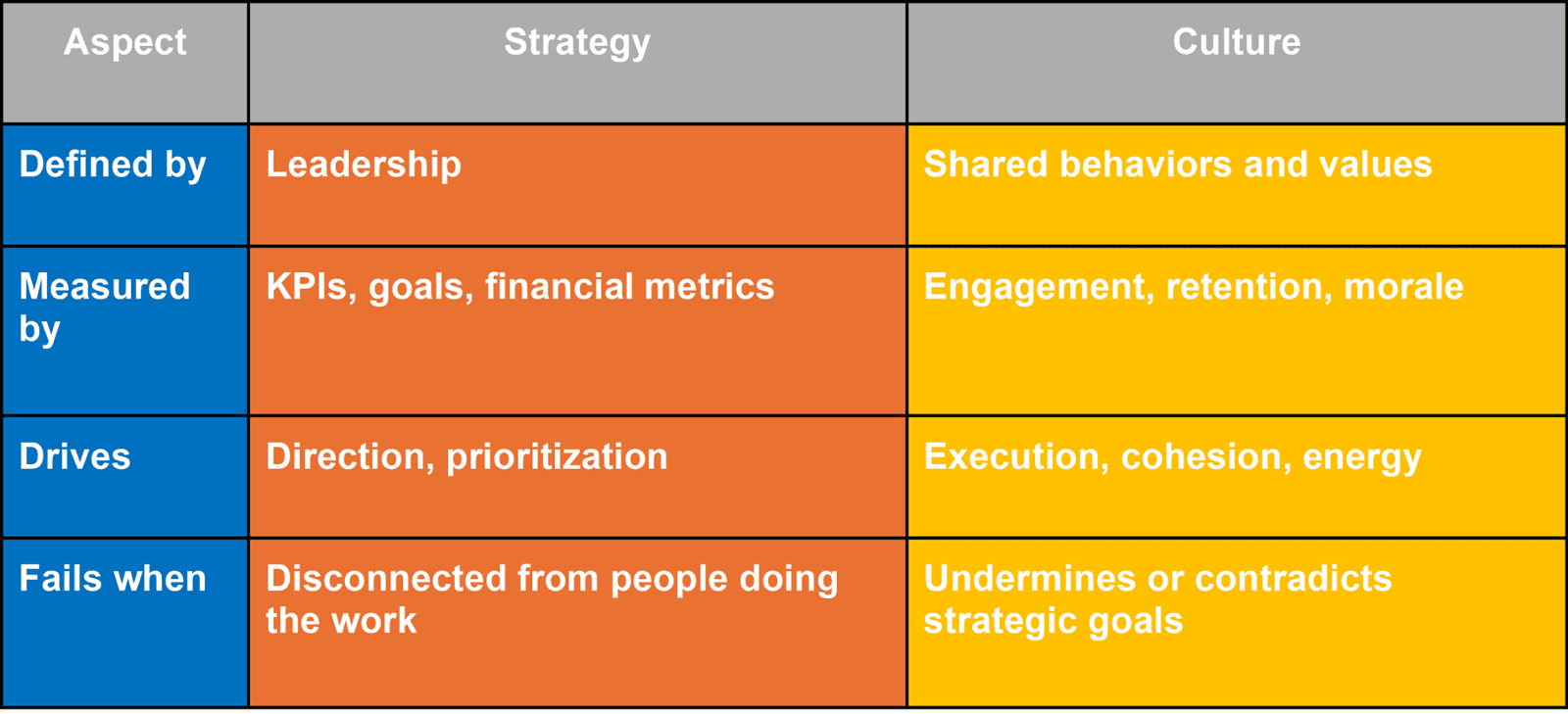Where Strategy Leads, Culture Delivers.

In the world of business, strategy often gets the spotlight. It’s measurable. It’s logical. It makes people feel in control. But culture? That’s the heartbeat of the organization — and without it, even the most brilliant strategies can fall flat.
At Blueneck, we work with blue-collar business owners across Canada who are excellent at what they do but often feel stuck when it comes to scaling operations or managing growing teams. What we’ve seen over and over again is this: long-term growth only happens when strategy and culture are aligned. If they’re not, the result is friction, confusion, and missed opportunities.
Let’s explore why alignment matters, how misalignment shows up, and what you can do to build a workplace where strategy and culture support each other — and your business growth.
What Do We Mean by “Strategy” and “Culture”?
Strategy is the plan — your roadmap for where the business is going and how it will get there. It includes goals, priorities, timelines, budgets, and metrics.
Culture is how work gets done day-to-day. It includes your team’s attitudes, shared values, behaviors, and communication habits.
When aligned, culture reinforces strategic goals. When misaligned, culture becomes the silent killer of progress.

Why Alignment Is Non-Negotiable for Growth
According to a study by Harvard Business Review, companies that successfully align culture and strategy experience up to 30% higher employee retention and 20% stronger performance metrics than those that don’t.
Here’s why that happens:
- Engaged teams move faster. When people understand and believe in the vision, they work with more ownership and purpose.
- Consistent behavior builds trust. Strategy means little if execution is chaotic. A strong culture creates reliable ways of working.
- Less energy is wasted. Misalignment leads to friction, resulting in conflicting decisions, unclear priorities, or duplication of effort.
- Adaptability improves. Teams with strong cultural foundations (alignment) can pivot more easily when strategy changes.
Common Signs of Misalignment
Many of our clients at Blueneck come to us because they feel something is “off” in their business. Often, it’s a cultural misalignment with their strategy. Here’s how it can show up:
- New initiatives stall because people don’t buy in or don’t understand why the change matters.
- Turnover increases, especially among high performers who crave clarity and consistency.
- Leaders feel like they’re pushing a rock uphill — everyone’s busy, but progress feels slow.
- Employees play it safe, avoiding innovation or new ideas due to fear or confusion.
- Conflicts increase, often due to unclear expectations or poor communication.
If any of these sound familiar, you’re not alone — and you’re not stuck. Alignment is something you can build intentionally.

Aligning Strategy and Culture: Where to Start
So how do you go from feeling the friction to building alignment? It doesn’t happen overnight, but it can start today. The good news is you don’t need a major overhaul. You need a few clear, consistent steps that help your team understand where you’re going and how to show up along the way. Below are three practical ways to bring your strategy and culture into sync — starting with clarity.
1. Clarify Your Strategic Vision — and Share It Often
Too often, leaders have a clear plan in their heads but don’t communicate it clearly enough to their teams. Your people can’t support what they don’t understand.
- Translate goals into plain language.
- Explain the “why” behind decisions regularly.
- Use real examples to explain where the business is going and what success looks like.
Tip: Revisit your strategic vision quarterly with your team to keep it top-of-mind.
2. Define Your Cultural Anchors
What behaviors do you expect from your team? How do you want decisions to be made? What values do you reward?
Rather than a list of vague values on the wall, define 3–5 observable behaviors that reflect your culture. For example:
Value | Behavior in Action |
Accountability | Team members own their results, not just tasks |
Curiosity | Employees are encouraged to ask questions and suggest improvements |
Safety | Employees stop work if unsafe, no matter the deadline |
3. Hire and Promote with Alignment in Mind
Many businesses are desperate to fill positions, but hiring quickly can backfire if you’re not hiring for cultural fit.
- Build interview questions that reveal how candidates align with your values.
- Promote employees who not only perform well but also model the culture you want.
According to a study, poor hiring decisions cost businesses over $25,000 per bad hire, often due to a lack of cultural alignment.
A Real-World Example: From Stalled Growth to Scalable Systems
Client: A construction company in Canada with ~20 employees and $7M in revenue.
The Problem: The owner had ambitious growth goals and invested in technology, new trucks, and a marketing campaign. But nothing seemed to stick. People were confused, resistant, and stressed.
The Real Issue: The company lacked a shared leadership language, had unclear expectations across departments, and a culture that prioritized “just get it done” over long-term planning.
What We Did:
- Facilitated a strategic planning session with team leads.
- Clarified annual priorities and tied them to weekly operations.
- Introduced leadership coaching to build confidence and consistency across middle managers.
- Developed a cultural guidebook to support decisions and feedback.
The Outcome: Within a few months, they saw an increase in job profitability, and turnover began to drop. Team morale improved, and projects flowed more smoothly.
When Strategy Shifts, Culture Must Follow
Markets change. Teams grow. Customer expectations evolve.
If you’re adjusting your strategy — whether expanding, adding services, or going digital — your culture has to evolve with it.
You don’t need to overhaul everything at once. Try this:
Start by aligning one key behavior (like better internal communication) with one strategic goal (like faster project delivery).
How Blueneck Helps with Strategy-Culture Alignment
At Blueneck, we don’t just hand you a business plan and walk away.
We work shoulder-to-shoulder with you to build it by:
- Developing practical, actionable strategies tailored to your industry
- Clarifying and embedding values that reflect how your team actually works
- Providing leadership coaching to strengthen decision-making and communication
- Aligning operations, finance, and HR with your culture and goals
Our clients span trades and services — construction, agriculture, logistics, equipment, and beyond — and we know that success looks different for every business. That’s why we take a human-centered, collaborative approach.
Quick Self-Assessment for Strategy-Culture Alignment
Not sure how well your strategy and culture are aligned? This simple self-check can help. It’s not about being perfect — it’s about spotting the gaps that could be slowing your growth. Use the questions below to reflect on where things are working and where a few small shifts could make a big difference.
Question | Yes | No |
Does your team clearly understand your top 3 business goals? | ||
Are your values and behaviors consistent across departments? | ||
Do new hires consistently “fit” into the team quickly? | ||
Do your leaders reinforce the culture through their actions? | ||
Are major changes well-received or at least well understood? |
If you answered “No” to 2 or more, it might be time for a tune-up.

Final Thoughts: Culture Is Strategy
Peter Drucker once said, “Culture eats strategy for breakfast.” We’d revise that slightly: Culture and strategy should eat breakfast together.
When your people understand the vision, feel part of it, and are supported by systems that reinforce shared behaviors, growth isn’t just possible — it becomes sustainable.
Let’s Build a Stronger Business, Together
Want to align your strategy and culture for long-term growth?
We are ready to roll up our sleeves!
At Blueneck, we specialize in helping blue-collar leaders create organizations that perform with purpose. Whether you’re tackling workforce issues, struggling with operational bottlenecks, or preparing for expansion, we’re here to help.
Visit www.blueneck.ca to learn more or contact us for a free consultation.

